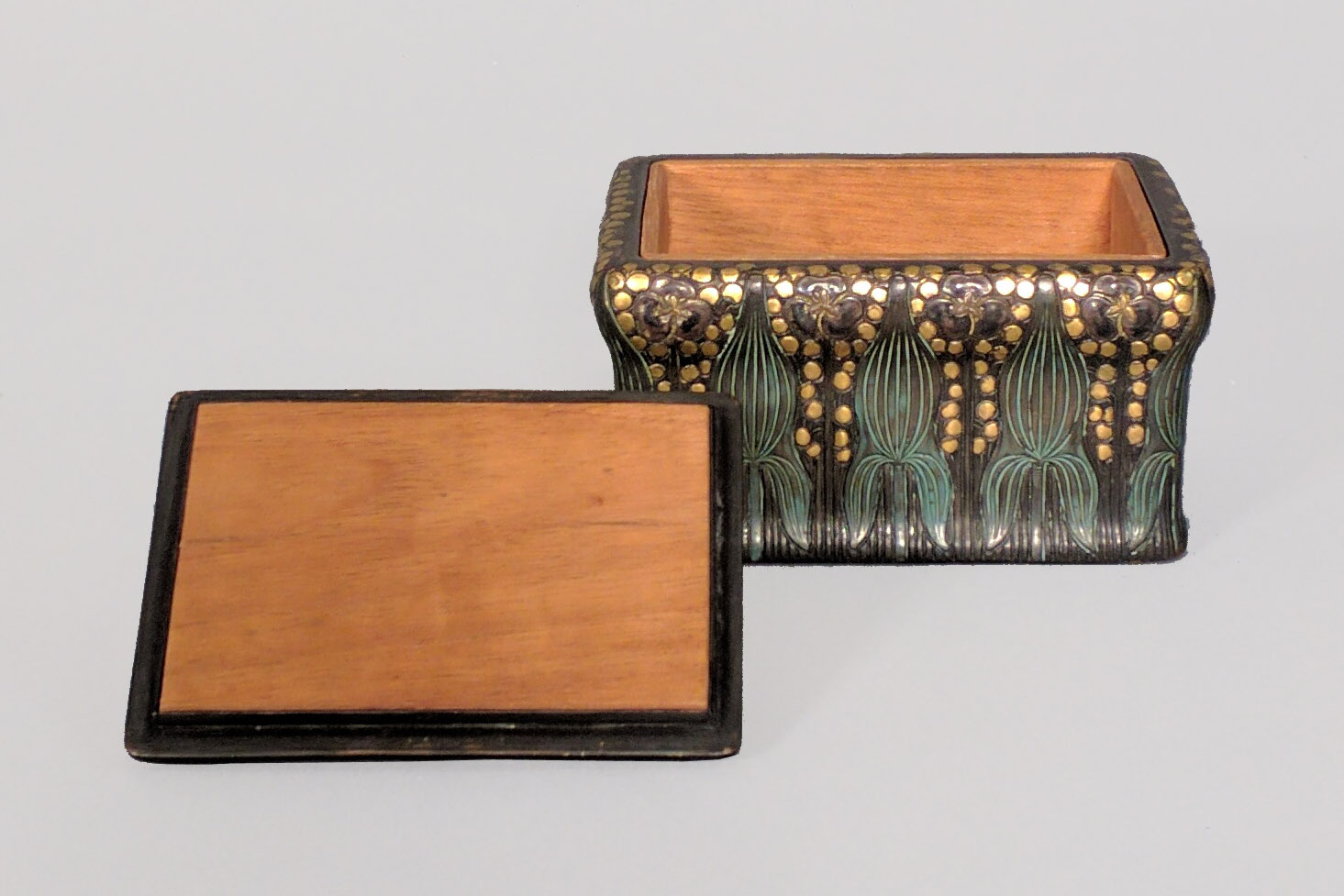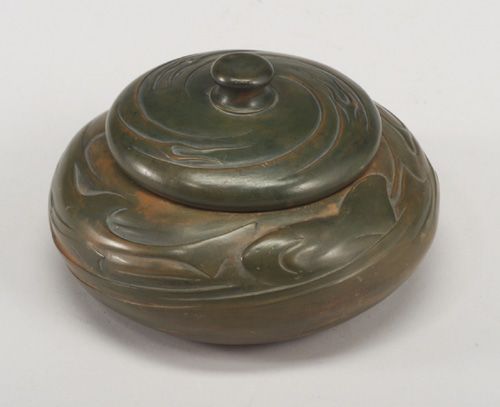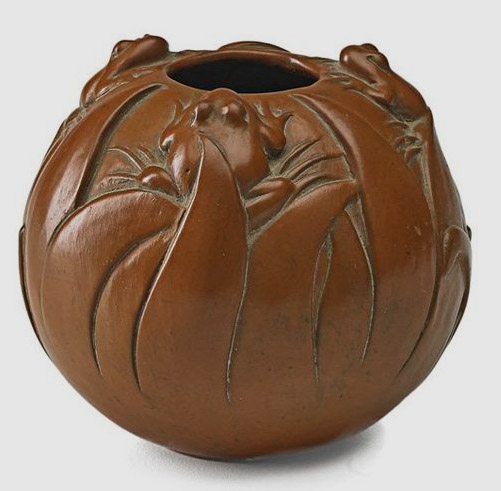Newsletter
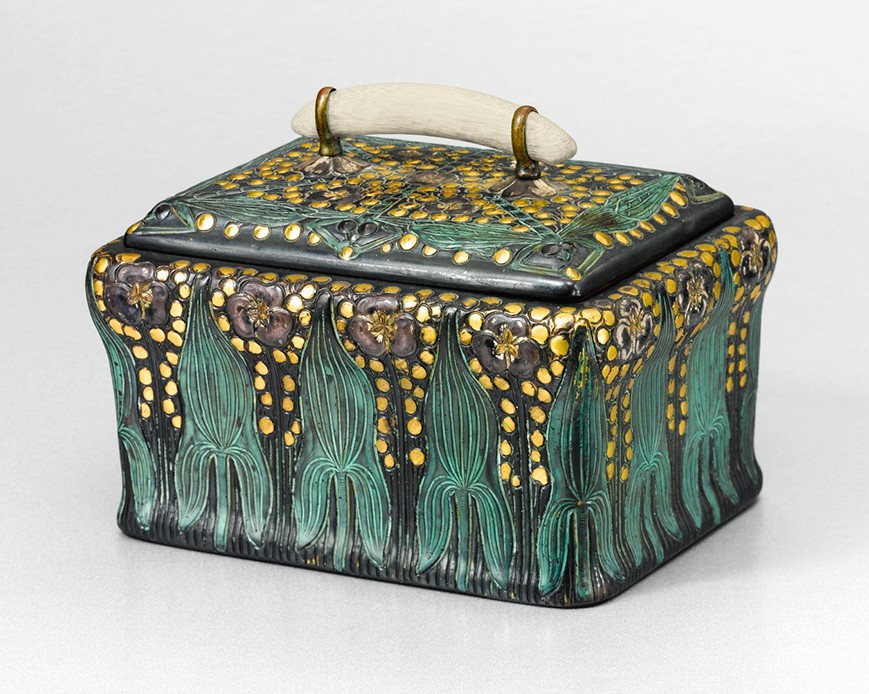
A rare “Dragonfly” and “Arrowhead” humidor, impressed TIFFANY STUDIOS/NEW YORK/S1752, silvered, gilt and enameled bronze with cedar-lined interior and ivorine handle 3 1/2 x 4 5/8 x 3 1/2 in., c. 1905.
At the June, 2017 Sotheby’s auction of the estate of legendary New York collector and antique dealer Carol Ferranti’s extraordinary Tiffany collection, Masterworks By Tiffany Studios, one item stood out from this amazing group for the TRRF’s Founder, Rudy Ciccarello. A longtime admirer of the work from Tiffany Studios (having several remarkable examples currently in the collection), along with his new found interest in A&C jewelry and boxes, he found the presentation of the very rare “Dragonfly” and “Arrowhead” humidor particularly appealing and is pleased to add it to the TRRF collection.
The following represent observations from two respected A&C scholars:
Tiffany authority and author Dr. Martin Eidelberg --
“This beautifully decorated box is quite unique in the oeuvre of Tiffany Studios for its highly patterned surfaces. The lid has a design of conventionalized dragonflies, while the sides are upright arrowhead leaves with the plant’s flowers filling the interstices. These patterns are not unlike those seen in French design books like Eugene Grasset’s La Plante et ses applications ornementales. Equally unusual is the addition of silver and gold plating, as well as green enameling. Unlike the spontaneity and bold coloring of the works from the Enamel Department at Tiffany Studios, here the enameling is cool and even in tone. Like patina, it carefully reinforces the relief design.”
Arts and Crafts Jewelry expert and author Elsye Zorn Karlin --
“This rare tour-de-force bronze tobacco chest is among the finest examples of Louis Comfort Tiffany’s design embellishment on metalwork objects. Evoking elements of Art Nouveau in its curvilinear design as well as the Arts & Crafts movement with green enamel which “reads” as patinated metal, it is a highly unusual piece to come out of Tiffany Studios. Although enamelwork was still in its early stage for the firm at the time this piece was crafted, the attention paid to detail, the extravagance of the design, and the coloration is visually arresting. It stands apart from his firm’s other enamelwork on copper that is less precise in execution and usually possesses an iridescent quality.
A box of the same design exists which lacks the visual impact created by the green enamelwork that is unique to this humidor, and so suggests it may have been an earlier prototype. Although several other objects were made by Tiffany Studios with a similar design aesthetic, the dragonfly and arrowhead humidor may well be the best piece produced in this limited genre.” These remarks speak to the rarity, materials, condition, complexity of design and the natural beauty of this one-of-a-kind example from Tiffany. It will join other A&C boxes and jewelry in the TRRF collection and will be featured in the Museum of the American Arts and Crafts Movement currently under construction in the Downtown section of St. Petersburg, Florida.
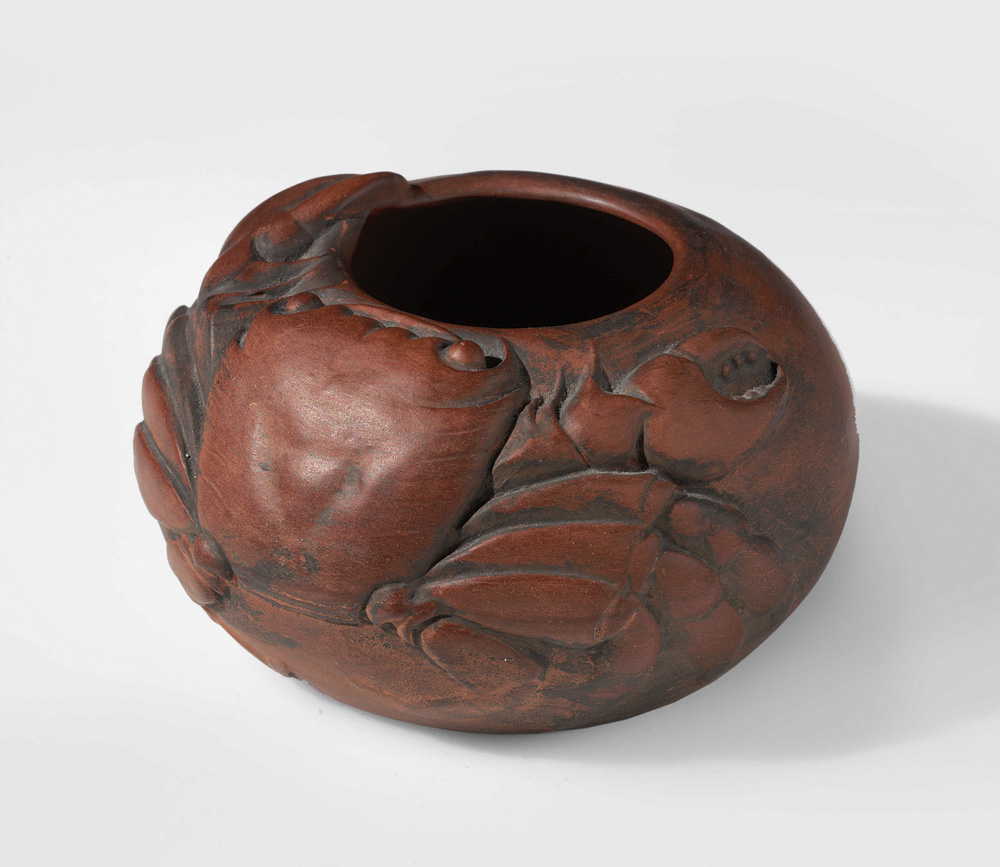
Redlands Crab Vase, marked “Redlands Pottery” around a circle enclosing a tadpole, glazed earthenware, 2 1/4 x 4 in. diameter, c. 1904-1909.
The turn of the twentieth century welcomed the American Arts and Crafts Movement to Southern California and the picturesque town of Redlands. Incorporated in 1888, and lying at the southern base of the San Bernardino Mountains roughly sixty-five miles east of Los Angeles, the area was rich in prime clay deposits and home to wealthy business magnates seeking to escape the harsh winters of the northeast.
Wesley H. Trippett was born in New York in 1862. There is precious little record of Trippett’s early year’s or his artistic training. It is known that while in his twenties he was employed as a metal designer for such prestigious firms as Tiffany Studios and J. L. Mott Iron Works. A move to California in his early thirties to take advantage of its mild and healthier climate may have been prompted by his battle with tuberculosis, which eventually took his life. He ultimately settled in Redlands around 1895, purchasing a small section of an olive grove and built a home which became his studio. Unable to find work as a metal designer, Trippett used his skill and experience with clay modeling to become a very accomplished potter. After experimenting with local clay deposits and taking it upon himself to build his own potter’s wheel, Trippett founded Redlands Pottery around 1904. Thought to be the areas first pottery and working alone, the Redlands Pottery was a classic one-man show. Trippett produced a small repertoire of bowls and vases. He was inspired by the color of the California clay and by animals and plants indigenous to the West Coast, including crabs, frogs, insects, spiders, sharks, eucalyptus leaves and pods. Trippett employed bisque finishes for most of his vessels in order to reveal the color and quality of the local California clays. David Rago of Lambertville, New Jersey, dealer and mid-century American pottery expert, says:
“Redlands produced a limited number of molded, low-fire, red clay pieces, fully embossed with critters and insects. While many of Redlands examples may have benefited from a second firing, many were finished in either a simple red clay color or embellished with a burnished, bronze-like patina. Most of the pieces that have surfaced so far are decorated with embossed designs, almost entirely decorated with animated creatures.”
It is thought that Trippett closed Redlands Pottery in 1909. In 1911, he joined the prestigious California China Products Company near San Diego as their Art Director. It is said that CCPCo, founded in 1911, practically revolutionized Southern California's architectural landcape with the introduction of its production of “Hispano-Moresque” faience tiles. Trippett died in 1913 at the age of fifty.
